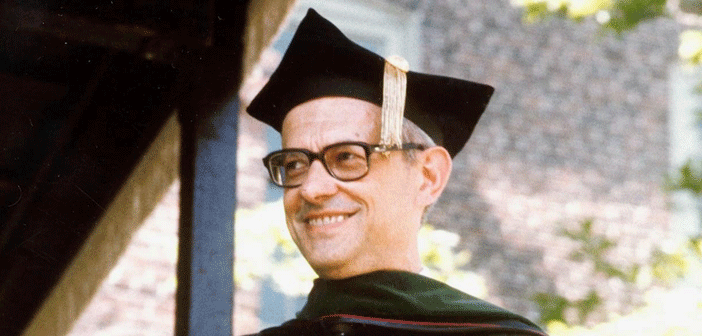Stanley M. Aronson, MD, whose legacy includes co-founding the Alpert Medical School of Brown University and Home & Hospice Care of Rhode Island, died in hospice care in Providence on Jan. 28, 2015. Colleagues remember him as a man who was great in many different ways, but who practiced and preached humility and humanity in everything he did.
Stanley Maynard Aronson, MD, founding dean of the Warren Alpert Medical School of Brown University, who exemplified and taught both excellence and humility in medical practice, died Wednesday, Jan. 28, 2015, at the age of 92.
“In conversations with Stan during the last several years, I came to understand how pleased he was with the growth and development of the Medical School he did so much to create,” said Brown President Christina Paxson, PhD, P’19. “His natural humility prevented him from taking credit, but Brown’s medical school and many of the statewide improvements in medical care delivery that grew along with it began with Stan’s arrival in Providence.”
“I will always remember Stan as the embodiment of a polymath, a person who knows everything about everything, yet he was caring, humble, and anxious to help others,” said Joseph Friedman, MD, professor of neurology and the Stanley Aronson Chair in Neurodegenerative Disorders at Butler Hospital.
Richard Besdine, MD, a gerontologist who served as interim dean of medicine from 2002 to 2005, agreed that for all of Aronson’s accomplishments and intellect, he lived for the good of those around him. “He was attentive to and caring about virtually every person he ever met,” Besdine said. “Helping people improve was a huge satisfaction for him. In all his roles—scientist, physician, academic leader, and mentor to many—he always cared about the people. He also knew more about more things than any person I have ever met, but personally was modest to a fault.”
Establishing a Medical School
Aronson was born, educated, trained as a physician, and employed as a doctor and medical professor in New York City, but in 1969 he and his first wife, Betty, decided to raise their children outside the city. An accomplished neuropathologist who published more than 400 research papers and made important contributions—to the development of laboratory tests for Tay Sachs disease and muscular dystrophy, among others—he accepted a job as chief of pathology at Brown University and The Miriam Hospital.
“Dean Aronson’s relocation to Providence was contingent upon one thing: that Brown would develop a medical school,” Jack A. Elias, MD, dean of medicine and biological sciences, recently wrote. “We have to commend his leap of faith. With his experience, Dean Aronson could likely have entertained positions at any academic medical center in the country, and seriously considered an appointment at Johns Hopkins School of Medicine in Baltimore. Instead, he chose the far more challenging, and frankly uncertain, task of building a medical school from the ground up at Brown.”
Aronson worked tirelessly with then Provost Merton Stoltz and others to achieve that goal, advocating for the idea within Brown and around the state to build support. The school launched in 1972 with modest means—43 faculty members, 16 students, and little research infrastructure—but during his years as dean, 1973 to 1981, Aronson guided it through its crucial first accreditation and blazed the trail of its growth.
The University honored Aronson with a Doctor of Medical Science degree, honoris causa, conferred at Commencement May 27, 2007.
As dean, Aronson created of one of the nation’s first departments of family medicine in 1978. He also inaugurated the Early Identification Program, a special route of admission for college students from Rhode Island as well as from Tougaloo College, the historically black college in Mississippi with which Brown has had a 50-year partnership.
He said he did not expect the growth the school has achieved.
“It has grown more aggressively than we envisaged and I’m not displeased,” he said. “I am pleasantly surprised that we have come this rapidly.”
Aronson gave the credit for the School’s early success to the first “charter” 16 students, whom he noted had the courage to prosper at a fledgling institution with no reputation and an uncertain future.
“We had a group of graduate students at Brown,” he recalled. “We asked them, ‘Your records are excellent, you could probably get into Harvard or Boston University immediately. Would you gamble on a school that does not even have a building, has a faculty so small in number that we could fit the entire faculty in one class room. We don’t have permission from the federal government to go ahead. Are you willing to gamble?’”




